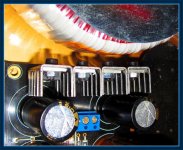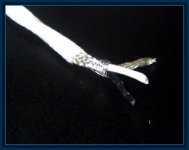My DCB1 works!!!
Here are some nekkid photos.
He, he, industrial punk DCB1, I like.
Very roughly the C/W rating varies with the square root of the height.
If 3" is 0.9C/W @ deltaT=75C
the 4" is sqrt(3/4)*0.9 = 0.78 @ deltaT=75C.
If deltaT ~8C the apply a de-rating factor (DF) of ~ 1.6.
i.e. deltaT (s-a) ~ 1.6 * 0.78 * 0.9 * 12W ~ 13C
For 30W expect the DF to be somewhere from 1.3 to 1.5.
My post tells you.Hmm sorry but means DF ?
need advise :
- pict 1 : is it OK if mur820 heatsink connected each other? or should it be insulated? currently i'm using power glue to attach them
- pict 2 : is cable shield meant to be connected as input ground (hence only need 1 cable for L/R)? or cable shield is not connected?
Thanks
- pict 1 : is it OK if mur820 heatsink connected each other? or should it be insulated? currently i'm using power glue to attach them
- pict 2 : is cable shield meant to be connected as input ground (hence only need 1 cable for L/R)? or cable shield is not connected?
Thanks
Attachments
Grounding.... right now, I have only the earth ground to case. I need to ground the phono section/TT somehow.
The phono section is Peter Daniels. The TT grounds directly to power supply common. I have *no* idea how that PS common is attached to earth... probably not.
When I take a wire from the ground post on the phono section and attach to case of the DCB1, touching the TT arm no longer makes hum. The case is tied to the earth/safety ground on the DCB1.
It does not seem right to ground PS common of the phono section to earth ground via this wire.
I read that AndrewT suggests the signal ground be lifted from earth/case ground via two diodes, in parallel with one reversed. I shall add a ground lug (ie speaker post) to the DCB1 and tie it to earth/case ground via the two diodes. The phono section power supply common will be tied to that speaker post as well.
The phono section is Peter Daniels. The TT grounds directly to power supply common. I have *no* idea how that PS common is attached to earth... probably not.
When I take a wire from the ground post on the phono section and attach to case of the DCB1, touching the TT arm no longer makes hum. The case is tied to the earth/safety ground on the DCB1.
It does not seem right to ground PS common of the phono section to earth ground via this wire.
I read that AndrewT suggests the signal ground be lifted from earth/case ground via two diodes, in parallel with one reversed. I shall add a ground lug (ie speaker post) to the DCB1 and tie it to earth/case ground via the two diodes. The phono section power supply common will be tied to that speaker post as well.
Well, that did not work. There is a higher pitched buzz this way. I wonder if routing the signal ground wire past the toroid is a problem?
Perhaps the ground lug has to be connected to PS common on the DCB1 as well? That tie the PS commons of the phono section and the DCB1 together. From there it is the back to back diode to earth.
Any problems with this approach? When the phono PS common was connected to DCB1 case and therefore earth, there was no noise. To do that, I remove the diodes....
Perhaps the ground lug has to be connected to PS common on the DCB1 as well? That tie the PS commons of the phono section and the DCB1 together. From there it is the back to back diode to earth.
Any problems with this approach? When the phono PS common was connected to DCB1 case and therefore earth, there was no noise. To do that, I remove the diodes....
On closer inspection, the buzz was nothing more than the ground wire from the left channel coming off the rca.
Grounding the phono section PS common to the case of the DCB1 via parallel diodes (one reversed polarity) is dead quiet.
Thanks for everyone's help. I will keep you posted on the progress of the modifications.
Grounding the phono section PS common to the case of the DCB1 via parallel diodes (one reversed polarity) is dead quiet.
Thanks for everyone's help. I will keep you posted on the progress of the modifications.
I have been playing all day, and wanted to see if the CD sounded like the phono section.... I was trying to hook up a benchmark dac. I plugged it into a different wall outlet from the rest of the system.
Hooked it up with the power out, and when I turned it on, there was as buzz. I turned it off, the relay clicked off. Tried to power up again with all units in the same house circuit, and the fuse blew.
No smell or smoke. Initial blown fuse was 1 A.
Replacing with another preamp, shows that the left channel line out from the pre had shorted when I was struggling to attach the CD player.
I only have 500 ma fast blow fuses left, 10R resistor (200 ma bias), 80 VA 2x15 volt 117 VAC primary toroid.
So, even with inputs and outputs disconnected the 500 ma fuses blow before the relay can click. Only the groups of three light up and the groups of 5 stay completely unlit -- both sides.
I suspect that the shorted cable on the output took out the 1A fuse and now the unit can't even power up with the 500 ma fuse in place?
What size fuse should I be using?
Hooked it up with the power out, and when I turned it on, there was as buzz. I turned it off, the relay clicked off. Tried to power up again with all units in the same house circuit, and the fuse blew.
No smell or smoke. Initial blown fuse was 1 A.
Replacing with another preamp, shows that the left channel line out from the pre had shorted when I was struggling to attach the CD player.
I only have 500 ma fast blow fuses left, 10R resistor (200 ma bias), 80 VA 2x15 volt 117 VAC primary toroid.
So, even with inputs and outputs disconnected the 500 ma fuses blow before the relay can click. Only the groups of three light up and the groups of 5 stay completely unlit -- both sides.
I suspect that the shorted cable on the output took out the 1A fuse and now the unit can't even power up with the 500 ma fuse in place?
What size fuse should I be using?
800mA to 1A Slow fuse.
Seems something heavier happened than just a shorted output. That's the state of both outputs before the relay opens them each time you power up anyway. Is there a way that the top of the transformer mounting can short to chassis, or some heavy lines have small distance and could have touched?
Seems something heavier happened than just a shorted output. That's the state of both outputs before the relay opens them each time you power up anyway. Is there a way that the top of the transformer mounting can short to chassis, or some heavy lines have small distance and could have touched?
The transformer is potted. It does the same when transformer is out of case.. maybe the switch is poor? I want to move the power to under board, to give the diodes some room.
It could simply be that the 1A fast blo was too close, and the 500 ma are undersize.
Will the fusing requirements change for 600 ma hotrod? I have 2A sand filled glass fuses here. Should I try them?
It could simply be that the 1A fast blo was too close, and the 500 ma are undersize.
Will the fusing requirements change for 600 ma hotrod? I have 2A sand filled glass fuses here. Should I try them?
If you will try them 2A they could be too tolerant if something has blown in the regs indeed.
The transformers most of the times have a recommended primary fuse rating and type on their labels. Else you can divide VA/Wall VAC and closely fuse with T slow type or give it +25% if it keeps on blowing it. NTC thermistor is a simple soft start add on in case of really large transformer.
The transformers most of the times have a recommended primary fuse rating and type on their labels. Else you can divide VA/Wall VAC and closely fuse with T slow type or give it +25% if it keeps on blowing it. NTC thermistor is a simple soft start add on in case of really large transformer.
I can't see 80 va needing a soft start, but what do I know? I am a rookie. If it just a matter of getting the toroid going, the 2A will do that...it just won't offer any significant protection downstream. If downstream is already fried, can it get any worse?
The secondaries are not shorted,nor are the primaries. I will check if the switch shorts to case when on.
The secondaries are not shorted,nor are the primaries. I will check if the switch shorts to case when on.
So, to summarize this result... 80 VA toroid, 117 volt primary, 2x15 volt secondary (2.7A max) blows a 1A fast blo fuse on startup.
1A slo blo fuse seems to work.
As AndrewT says, a CL60 could be used. Then using Salas' estimate of 80VA /117 VAC and adding 25% gives 854 ma fuse rating. (note 20% gives 780 ma...). Using a combination of CL60 with a 800 ma to 1A fast blow would then offer better protection.
1A slo blo fuse seems to work.
As AndrewT says, a CL60 could be used. Then using Salas' estimate of 80VA /117 VAC and adding 25% gives 854 ma fuse rating. (note 20% gives 780 ma...). Using a combination of CL60 with a 800 ma to 1A fast blow would then offer better protection.
- Home
- Source & Line
- Analog Line Level
- Salas hotrodded blue DCB1 build


